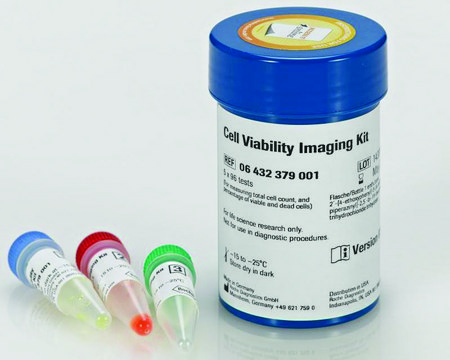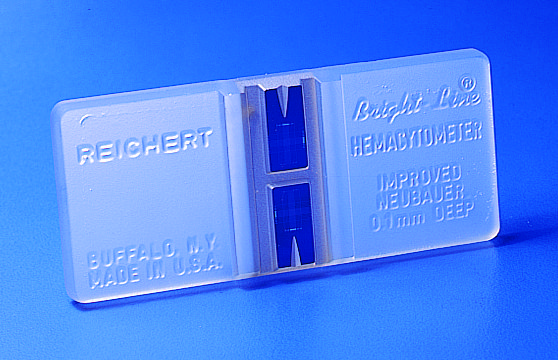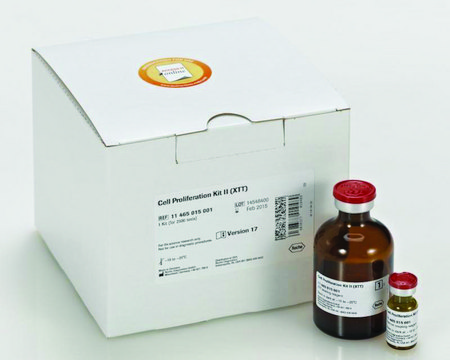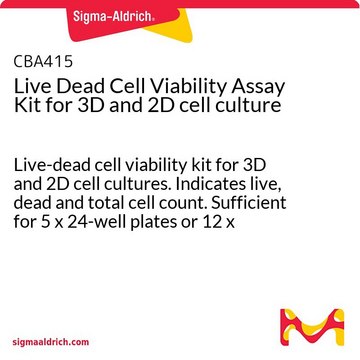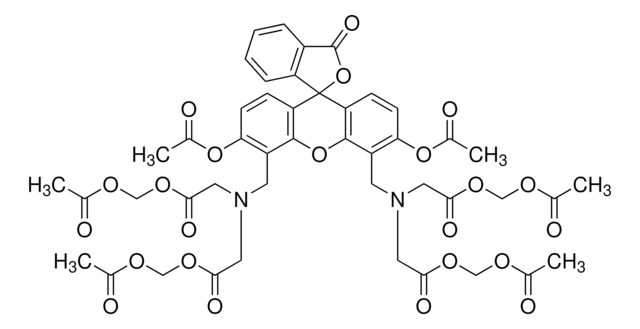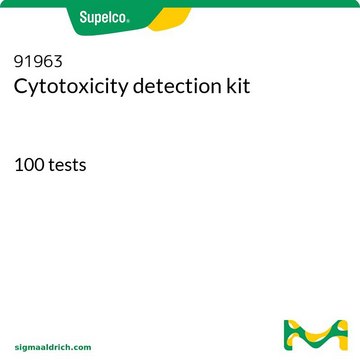03285
Cell Counting Kit
sufficient for 500 tests
Synonym(s):
Fluorescent Cell Counter
Sign Into View Organizational & Contract Pricing
All Photos(1)
About This Item
UNSPSC Code:
12352116
eCl@ss:
32161000
NACRES:
NA.32
Recommended Products
General description
Cell Counting kit, also known as FCCK, is a fluorescent cell counting product. The amount of a fluorescent dye, calcein, produced from Calcein-AM (3′,6′-Di(O-acetyl)-2′,7′-bis [N, Nbis-(carboxymethyl) aminomethyl]-fluorescein, tetraacetoxymethyl ester) by esterases in cells is directly proportional to the number of viable cells in a culture medium. Calcein-AM is highly lipophilic due to the presence of acetoxymethyl groups in the molecule, which rapidly permeates into the cell cytoplasm through the membrane.
Application
Cell Counting Kit or FCCK is used for the detection of live cells by fluorometric method.
Features and Benefits
Cell Counting Kit has the following advantages:
- It doesn’t require any radioisotopes to function.
- No solubilization procedure is needed.
- Results are highly reproducible and accurate.
Storage Class Code
10 - Combustible liquids
Flash Point(F)
Not applicable
Flash Point(C)
Not applicable
Choose from one of the most recent versions:
Already Own This Product?
Find documentation for the products that you have recently purchased in the Document Library.
Zhongyi Zhou et al.
Aging, 13(7), 9838-9858 (2021-03-22)
Colorectal cancer (CRC) is a prevalent malignancy worldwide. The development of genome sequencing technology has allowed the discovery that epigenetic regulation might play a critical role in CRC tumorigenesis. In the present study, we found that the long noncoding RNA
Loss of MiR-664 Expression Enhances Cutaneous Malignant Melanoma Proliferation by Upregulating PLP2.
Zhenhua Ding et al.
Medicine, 94(33), e1327-e1327 (2015-08-20)
Proteolipid protein 2 (PLP2) has been shown to be upregulated in several cancers, including breast cancer, hepatocellular carcinoma, osteosarcoma, and melanoma. PLP2 specifically binds to phosphatidylinositol 3 kinase to activate the protein kinase B pathway to enhance cell proliferation, adhesion
Jianmin Li et al.
Laboratory investigation; a journal of technical methods and pathology, 101(2), 142-154 (2020-09-30)
Epithelial-to-mesenchymal transition (EMT) of epithelium and airway epithelial cell proliferation disorder are key events in idiopathic pulmonary fibrosis (IPF) pathogenesis. During EMT, epithelial cell adhesion molecules (EpCAM, such as E-cadherin) are downregulated, cytokeratin cytoskeletal transforms into vimentin-based cytoskeleton, and the
Nan Zhang et al.
Oncology letters, 12(6), 4589-4597 (2017-01-21)
MicroRNA (miR)-217 has been reported to participate in carcinogenesis and tumor progression in several cancers; however, its expression and biological functions in colorectal cancer (CRC) are still unclear. The present study demonstrated that miR-217 expression was significantly higher in matched
Bin Zhou et al.
International journal of molecular medicine, 46(4), 1571-1581 (2020-09-19)
Osteoporosis is a systemic metabolic bone disease during which bone mass decreases and bone quality is reduced. Maintaining the bone formation capacity of osteoblasts is crucial for the treatment of osteoporosis. In the present study, bioinformatics analysis was performed on
Articles
Cell based assays for cell proliferation (BrdU, MTT, WST1), cell viability and cytotoxicity experiments for applications in cancer, neuroscience and stem cell research.
Our team of scientists has experience in all areas of research including Life Science, Material Science, Chemical Synthesis, Chromatography, Analytical and many others.
Contact Technical Service


